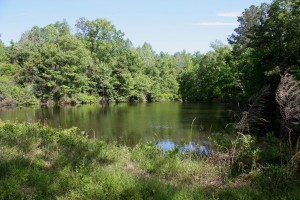 When we bought the land on which our farm sits six years ago (wow, has it really been six years?), we knew there was a one-acre pond on it but didn’t know much about it other than that it was lovely. Now that we’ve lived with it for awhile we know more about it:
When we bought the land on which our farm sits six years ago (wow, has it really been six years?), we knew there was a one-acre pond on it but didn’t know much about it other than that it was lovely. Now that we’ve lived with it for awhile we know more about it:
- It’s teeming with life both above and below the surface, including tadpoles, frogs, turtles, fish, insects, grasses, waterfowl, and snakes.
- Fed by underground springs and having good dam integrity, the pond stays full. Its water level has never varied more than an inch or so.
- The pond is at least 50 years old. It has trees growing on the back side of the dam, which is never a good thing, because those trees create root channels into the dam that could later weaken it and allow the dam to leak.
- Did I mention that it’s lovely?
- Those who have tried to fish in it seldom catch anything, and we assume the pond is “out of balance,” meaning it has too many little fish and not enough big fish. We also assume that over the years the pond has ended up with several desirable and undesirable species of fish.
- Over the years the vegetation has built up around the edges of the pond to a point that it constantly catches lures and hooks.
We have consulted perhaps half a dozen experts about how we can resurrect the pond so that it can be viable for fishing again. Their recommendations have tended to cluster around two core strategies:
- Kill Everything and start all over.
- Hire me and pay me $1,000 or so to do an exhaustive analysis of the pond so I can tell you exactly what you need to do, which is likely to be Kill Everything and start all over.
I’m not saying that we couldn’t be persuaded to Kill Everything. If we became convinced that this was the only way we could restore the pond to viability as a food source for humans, we probably would hold our noses and do what had to be done. It’s just that the prospect of Kill Everything is so painful to us that we’re willing to spend money and take considerable time to explore alternatives to it. Last Friday we had a delightful conversation over lunch with one of the aquaculture scientists at Auburn, Dr David Cline. He couldn’t have been more helpful. He listened patiently as we laid out what we know about the pond and as we told him our goals for it:
- Not all that interested in trophy bass.
- Not all that interested in swimming.
- We want it to be a reliable source of protein to complement the other sources we’re developing.
- We want our children, grandchildren, and other guests to be able to fish in the pond and have confidence they’ll catch something worthwhile.
Armed with Dr Cline’s recommendations, we now have a low-budget Patience Plan for resurrecting the pond:
- Leave the dam alone. Now that the trees are growing on it, let them be and hope for the best.
- Introduce into the pond now eight sterile grass carp, large enough so that they won’t be immediately eaten by any big fish now living in the pond (9-11 inches).
- This fall, introduce 500 bluegill (you probably know them as bream). This should give them time during the winter to spawn a couple of times.
- In June, introduce 50 bass. They should be able to feed on the bream and put on good growth over the summer. We should be able to fish for bass and bream by the fall.
- Once we reach this point, the pond needs to be fished regularly. If not, it will get out of balance again.
- At any point. including now, we could also choose to raise catfish in one or more cages in the pond. Catfish will multiply rapidly and compete with the bass for food, so it’s not a good idea to introduce them into the same ecosystem with the bass. But we could keep them in a cage, feed them catfish food, and harvest whenever we want fresh catfish fillets. The catfish food and waste from the caged fish will act as fertilizer for the pond ecosystem. The catfish will not reproduce in cages, so we would need to start with a fresh batch from time to time.
We took the first steps yesterday when we bought and introduced the grass carp into the pond. Obviously, there is a chance that our Patience Plan will fail. The advantage of it is that our investment in it is modest – $4-500 and some time. If it doesn’t work, there’s always Kill Everything.
Pingback: Podcast #183 – About Our Pond « Longleaf Breeze